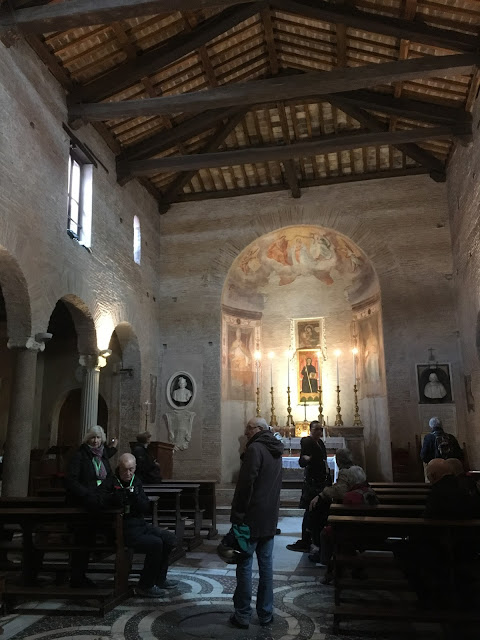Or maybe I haven't. Not this way.
Now that I've been taking Italian language classes since September, I can safely say that it's utterly crazy to move to a place and not take local language lessons. You may struggle with adopting new sounds, words, grammar and syntax, but you will gain a lot of awareness of local culture - including the occasional admission that the language textbook has included something that "(fill in the name of the people) NEVER say."
My Italian language teacher is a native Roman. He has been great to work with, even if I am constantly on the struggle bus. I think that I may know more words and verb conjugations than either of us believe when I am stammering away in front of him. I can speak fairly competently in my own language in front of a crowded room of strangers or even colleagues - with zero problems - but when my language teacher looks at me warmly while I try to answer his simple question 'what did you do this past weekend?' I completely UN-remember everything.
And you know, of course, that because I want to be a good educator, I also want to be a good student.
At the very least, we can all rest assured that I will continue to be a good student of this place - if not its language.
I've already mentioned that my teacher and I have bonded over the topic of baking, and I've proudly brought pictures of my pizzas made with the 25 year old lievito madre he shared with me.
Because he knows my discipline (and he previously wanted to formally study art history), he often shares information about exhibitions and other cultural events in the city.
So after class last week, he described a unique Roman tradition related to this holiday weekend.
In observance of Maundy Thursday - and what would have been recognized as the evening of Christ's Last Supper and the foot-washing and also Christ's agony in the garden - all Roman churches, even the ones you can rarely visit, keep their doors open late into the evening.
Sometimes, the interiors are only lit by candles.
Sometimes, a special chapel is opened and prayers or short sermons are conducted in front of the blessed sacrament.
Sometimes, people merely sit and keep a vigil, honoring Christ's request to 'watch one hour with me.'
Sometimes, a particular altarpiece or statue is shrouded. Crosses are draped and covered.
Every church is different.
But it is Roman tradition that you process through the streets, visiting a minimum of 7 (or 14 - one for each Station of the Cross) churches.
My teacher then said: I get together with friends every year on this evening. We have a light meal and some drinks, and then we walk. We visit some churches. You are welcome to join us.
Anyone who knows me knows that this is the kind of invitation I would never turn down.
So The Spouse and I joined about a baker's dozen of people - of various origins in and outside of this country, but all now living permanently in Rome - at a small enoteca in Trastevere this past Thursday evening.
There are no photos of this part of the night, because being a spectator at that point would have meant that I wasn't trying to immerse myself in getting to know locals.
(I must insert here my fascination with the Roman manner of arranging for food and drinks to be served to a group. I have read that 'Romans talk their food to the table,' and it's totally true. Nothing that arrives is exactly the way the menu portrays it...deals are made even in the basic order exchange between server and customer)
Once we finished our time at the enoteca, we took off for the stroll to a number of churches - almost all of which I have visited at least once, and in some cases, many times before.
But that fact was pretty meaningless this evening.
First, a lone chapel in San Francesco a Ripa.
Then, the impressively glowing Santa Maria del Orto
And then, Santa Cecelia
San Benedetto in Piscinula (the first three images show you this modest church in the day time, first)
Saint Agatha's draped altar for the Blessed Sacrament at night, below:
And a shrouded statue in the same church:
St. Bartholomew on the Isola Tiberina (Tiber Island), selectively lit with a few candles as well as its regular lighting.
Our short break by the Tiber.
And on to St. Chrysogono, where those gathered recited the Hail Mary.
And last, but certainly not least, Santa Maria in Trastevere, said by many to be the first church dedicated to Mary.
I have often said that 'museums are my churches and churches are my museums.'
I still hold that to be true, but on this night, the churches I had already visited before (all but St. Chrysogono) turned back into churches.
They became what they were meant to always be: spaces for the living, in which to think intentionally and act spiritually. Intimate theaters for the performance of ritual, where the 'props' were re-engaged in the moment, even when (and perhaps especially when) they were intentionally hidden from view. Contemplative spheres, where what is known is enfolded within mystery. Dark enclosures, where light is treasured, individually perpetuated, and awarded its original significance.
May your time - this time - with family and friends be similarly about engaging the familiar with the new. May the spaces you frequent feel different because of the people that inhabit and enliven them.
Buona Pasqua.



















Happy Easter to you, too, my friend. Thank you so very much for this post. The pictures are lovely, but your text hits home. I love the idea of visiting the churches. Would have loved to have traversed them with you. The mysteries and sacraments reach their fullness on this holy weekend. Peace.
ReplyDelete